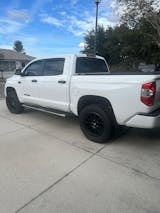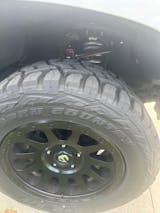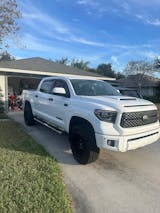Diode Dynamic Rock Lights on our Tremor
Posted by Derrick Lovell on
It has been MONTHS of anticipation from Diode Dynamics on some of their products coming out. One of big ones being their new Rock Lights. We first previewed these lights back in SEMA of 2022. At first glance we were immediately intrigued. We say intrigued because over the years; rock lights have become more of a fashion than a function. Now don’t get us wrong; nothing wrong with looking good. But the concept behind a Rock light is in its name itself. Light up the rocks. But long past the days of just using such lights for one simple fashion. These days they have become extremely versatile, and we are here to confirm that these babies are legit.
Let's start with the overall design and build. The lights are very well made. Diode went through some serious torture testing on these lights to get them to function in the toughest conditions. The lens covers are a UV Coated Polycarbonate and create a nice watertight seal for the light but are fairly simple to get off. This benefits anyone who has the desire to change the lens color at any time. We chose to go with the RGBW lights on our Tremor and Tundra builds.
These lights are larger overall than most other applications out on the market. Diodes rock lights 2.4” x 2.4”. Compare that to Baja for example which comes in at a 2.7” x 1.2”. This can be both a pro and a con for some. Each light is 10watts and puts out 1,000 lumens. That is some solid light for sure. The ico-bezel style is also very attractive and gives these lights a really good look.
We are running a 6 light system on our Tremor. Diode does supply an install guide with each kit. Its very straight forward and easy to follow. Now for the actual install itself. The larger lights made it slightly more difficult to find a nice spot to install inside the front wheel wells. Our goal was to be able to light up as much of the ground as possible while still making the lights accessible. For this particular build, we had to push the lights back towards the engine bay and install them at a slight angle. We could have placed them directly in the middle or closer to the outside fenders; but with our wheel and tire set up too much light was being covered by the tires. So, this was our best option for our desired needs.

The rear lights were straight forward in terms of placement. But in order to install them, we had to remove our Husky liners in the wheel well and mark/measure where we wanted to the lights to be. Then we drilled two holes; one for the light to mount, and the other to run the wire. We chose to run our light as far back as we could before we hit the curve of the liner. This enabled us to get as much light behind the tires and the ground rather than just on top.



Now the middle lights caused a little bit of difficulty. Since these trucks use the aluminum body, mounting was challenging. We ideally wanted to use the surface mount and the supplied angle wedge to shine the light down. But when we put the mount up to test fit, we were getting more outward light than we were downward. That and mounting into the frame is no easy task. We ultimately decided to use the magnetic mounts that Diode has. But since the truck has an aluminum body, we had very few options to mount these. You can easily mount these onto the frame and they stay nice and secure. The only reason we did not do this is due to clearance. Since this is an overland build, we know that at some point these lights may come in contact on the trails. And we’d like to not lose a rock light while out there. We ultimately chose to place them on the bottom of the body mounts right in the middle of the truck. These magnets are strong; but since only about half of it was in contact with something metal, we chose to secure with some zip ties to add a little extra security. In order to do this, we drilled two small holes to feed the zip ties through so we could create an X pattern. This is a temporary fix for now. We plan to go go different route but this is working just fine for now.



Once you have everything mounted, the wiring is a simple plug and play. The connectors are water tight and they do have small arrows on them so you know how to line them up. We ran ours to the upfitter switches on our tremor but you can of course use the supplied switch as well. And if you have the RGBW Bluetooth controller then your color options are nearly endless. You can simply control everything through the app and choose any color you can think of! We highly recommend this added feature.

If you don’t prefer to have the Bluetooth then you may also use the 24 Key controller that they offer as well. Overall we are very pleased with these lights. And there are so many applications you can use these for. We will be adding some solid white lights to our Bed Rack system so that we have a nice cargo lit area (since the iKamper will illuminate the third break lights lighting). We hope this helps give some insight to these lights and as always, please reach out with any questions you may have!




-Derrick @ Hotshot Offroad
Build IG: @Hotshot_Tremor




